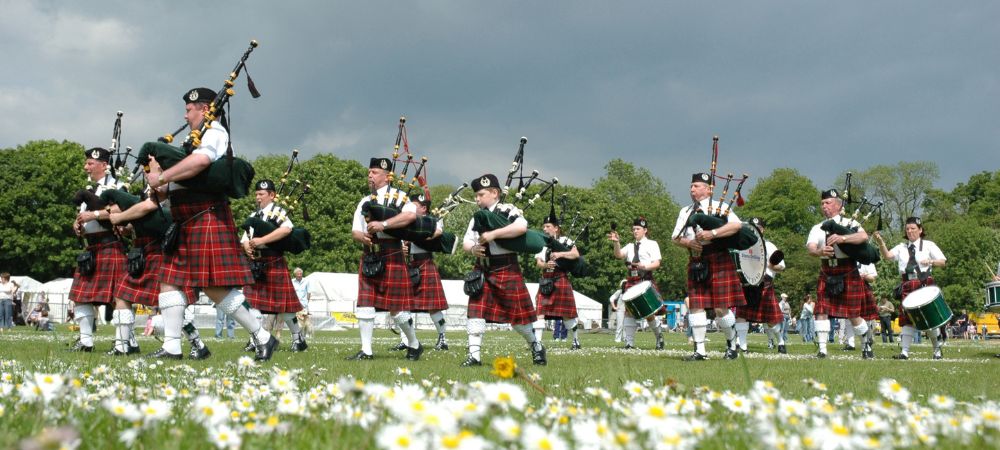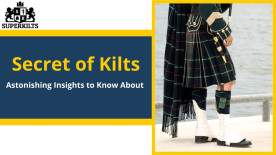Kilts, emblematic of Scottish culture, offer more than mere aesthetics. These garments, steeped in history, serve as a testament to heritage and tradition. Beyond their cultural significance, kilts boast an array of health benefits, often overlooked in conventional attire. This garment, characterized by its distinctive design, has evolved over time, integrating modern fashion elements while preserving its traditional essence.
In this discussion, we delve into seven persuasive reasons to wear a kilt. From making bold fashion statements to promoting physical well-being, kilts present a compelling case for inclusion in contemporary wardrobes, transcending their historical roots to offer practical, stylish, and culturally rich attire options.
Embracing Cultural Heritage and Identity

Kilts, deeply intertwined with Scottish history, symbolize more than just a national costume. They represent a deep-rooted sense of pride and cultural identity, connecting wearers to Scotland's rich heritage. Originating in the Highlands, the kilt was initially a full-body garment, designed to withstand the harsh Scottish climate.
Over time, it has evolved, becoming a powerful symbol of Scottish patriotism and heritage. Wearing a kilt is a means to honor and connect with one's Scottish ancestry, embodying a way of life that dates back centuries. It's a visual narrative of clan histories, with each tartan pattern signifying a different clan. For those of Scottish descent, and even for enthusiasts of Celtic culture, donning a kilt is a way to keep traditions alive and celebrate a rich history.
In a world where globalization often dilutes cultural uniqueness, the kilt stands as a proud beacon of Scottish identity, ensuring that ancient traditions continue to thrive in modern times.
Fashion Statement and Versatility
The women’s and men's fashion kilts have transcended its traditional boundaries to become a versatile element in modern fashion. Far from being a relic of the past, it has adapted to contemporary trends, offering a range of styles, patterns, and materials. The traditional tartan kilt, with its intricate patterns and vibrant colors, remains a popular choice for formal occasions such as weddings and banquets. However, the kilt's versatility is truly showcased in its various modern adaptations.
Utility kilts, made from durable fabrics and featuring pockets and buckles, are a stylish option for casual outings and outdoor activities. Leather kilts offer an edgy, avant-garde twist, appealing to those who wish to make a bold fashion statement. This adaptability ensures that kilts can cater to a wide range of personal styles and occasions.
The kilt's ability to bridge the gap between traditional elegance and contemporary chic makes it a unique garment in the fashion world. Whether worn for a formal ceremony or a casual meet-up, the fashion kilts for women and men are guaranteed to turn heads and spark conversations.
Comfort and Freedom of Movement
The kilt's design offers an exceptional level of comfort and freedom of movement, attributes highly valued in today's fast-paced lifestyle. Unlike trousers or jeans, kilts are not constrictive, allowing for a more relaxed fit. This loose design is particularly beneficial for activities that require a wide range of motion, such as dancing at a ceilidh or competing in Highland games.
The kilt's structure, with its pleats and open bottom, ensures ease of movement and a level of comfort that is hard to achieve with more conventional garments. For many, this comfort is the primary reason for incorporating kilts into their daily wardrobe. The breathability of the fabric, typically wool or a wool blend, adds to the comfort, making the kilt suitable for various climates and seasons. You can also give denim kilt for stylish women a try!
Furthermore, the adjustable nature of the kilt ensures a personalized fit, accommodating changes in the wearer's body size more easily than tailored trousers. This blend of comfort, practicality, and style makes the kilt an appealing choice for both special occasions and everyday wear.
Health Benefits: Improved Circulation and Ventilation
The health benefits of wearing a kilt are often overlooked yet significant. The kilt's loose fitting nature promotes better blood circulation compared to the restrictive nature of tight trousers or jeans. Improved circulation is crucial for overall cardiovascular health and can help prevent various health issues such as varicose veins and circulatory problems.
Additionally, the open design of the kilt ensures superior ventilation, reducing overheating and the potential for skin irritations or infections. This aspect is particularly beneficial in warmer climates or during physical activities where increased airflow can lead to greater comfort and better skin health.
The kilt's design also encourages more physical activity, given its ease of movement, potentially leading to a healthier lifestyle. Moreover, the absence of constrictive waistbands and seams means less pressure on the abdomen, which can aid in digestive health. The combination of these factors makes the kilt not just a fashion choice, but a healthier alternative to conventional clothing options.
Eco-Friendly and Sustainable Fashion
In an era of increasing environmental awareness, kilts stand out as an eco-friendly fashion choice. Traditionally made from natural fibers like wool, kilts align with sustainable fashion principles. Wool, a renewable resource, has a lower environmental impact compared to synthetic fabrics, which are often derived from fossil fuels.
Moreover, the production process of wool and other natural fibers used in kilts typically involves less water and energy consumption than that of synthetic materials. Additionally, these natural materials are biodegradable, contributing to a reduction in long-term waste.
Many kilt manufacturers are embracing sustainable practices, sourcing materials locally and minimizing their carbon footprint. The durability of kilts also plays a key role in their sustainability.
A well-made kilt can last for decades, reducing the need for frequent replacements and, consequently, the demand for new resources. This longevity also means that kilts often become heirlooms, passed down through generations, which further diminishes their environmental impact over time.
By choosing a kilt, wearers not only make a statement about their style but also about their commitment to sustainability and environmental responsibility. Visit a kilt shop to get your’s!
Gender Fluidity and Social Statement
The kilt is a unique garment in its ability to challenge and transcend traditional gender norms in fashion. Historically worn by men, the modern kilt has become a symbol of gender fluidity, embraced by all genders as a form of expression.
In defying the conventional dichotomy of men's and women's clothing, the kilt makes a powerful statement about inclusivity and the rejection of rigid gender roles. This shift reflects a broader social movement towards gender equality and the acceptance of non-binary and fluid gender identities.
Wearing a kilt can be an empowering act, a declaration of independence from traditional fashion norms that often limit self-expression. It encourages individuals to define their style on their own terms, without being constrained by societal expectations. In this way, the kilt serves not only as a garment but also as a vehicle for social change, promoting a more open and inclusive view of fashion and identity.
Longevity and Timelessness
One of the most compelling aspects of the kilt is its longevity and timelessness. A well-crafted kilt, made from quality materials, can endure for years, often outlasting other garments in a wardrobe. This durability stems from both the quality of the fabric used and the craftsmanship involved in its making.
Traditional kilts are often hand-sewn with attention to detail, ensuring that each pleat, hem, and fastening is robust and long-lasting. This resilience makes the kilt a cost-effective choice over time, as it requires less frequent replacement than more transient fashion items.
Furthermore, the timeless design of the kilt means it never goes out of style. It is as relevant and fashionable today as it was centuries ago, transcending fleeting fashion trends. The kilt's ability to endure not only physically but also stylistically ensures its continued relevance in any era.
Additionally, its longevity allows it to become a cherished item, rich with personal and familial history, often passed down through generations. Each kilt carries with it stories and memories, becoming more than just a piece of clothing, but a legacy.
FAQs:
1. What occasions are appropriate for wearing a kilt?
Kilts are versatile and can be worn for a variety of occasions. Traditional tartan kilts are perfect for formal events like weddings, ceremonial gatherings, and cultural festivals. Utility kilts, with a more casual and practical design, are suitable for everyday wear, outdoor activities, and informal gatherings. Kilts are also popular at Scottish Highland games and other cultural events celebrating Celtic heritage.
2. Can kilts be worn in different weather conditions?
Yes, kilts can be adapted to various weather conditions. Woolen kilts provide warmth and are ideal for cooler climates, while lighter fabrics like cotton are suitable for warmer weather. For rainy weather, some modern kilts are made from water-resistant materials. Layering with accessories like sporrans, knee-high socks, and jackets can also help adapt a kilt to different temperatures.
3. How do I choose the right kilt for me?
Selecting the right kilt involves considering the occasion, your personal style, and comfort. For formal events, choose a traditional tartan kilt that represents your heritage or a pattern you admire. For casual wear, utility kilts in various fabrics and colors offer comfort and functionality. Ensure the kilt fits comfortably around your waist and falls around the middle of the knee. Consider the fabric weight and texture for comfort and season-appropriate wear.
4. What accessories are traditionally worn with kilts?
Traditional kilt accessories include a sporran, which is a small pouch worn around the waist for carrying personal items, a kilt pin for decoration and to add weight to the kilt’s apron, knee-high socks (kilt hose), and ghillie brogues, which are traditional Scottish shoes. For formal events, accessories like a fly plaid, a sash of tartan worn over the shoulder, and a dress sporran can be added.
5. How do I care for and maintain my kilt?
Proper care and maintenance of a kilt are essential for its longevity. Wool kilts should be dry cleaned to preserve the fabric’s quality. For kilts made from other materials, follow the specific washing instructions provided. Store the kilt flat or hung with a kilt hanger to prevent pleats from losing their shape. Avoid storing in damp places to prevent mold and moth damage. Regularly check for any loose threads or buttons and repair promptly to maintain the kilt’s appearance and durability.
Conclusion:
Kilts offer a distinctive fusion of style, tradition, and practicality, transcending beyond mere clothing to become a meaningful symbol of heritage and identity. They are an embodiment of history, a tribute to rich cultural traditions, and a fashion statement with deep significance.
Whether you're drawn to their unique style, unparalleled comfort, or the symbolic values they represent, kilts are an exceptional choice for those seeking to make a fashion statement that resonates with deeper meaning.
Ready to embrace this unique blend of tradition and style? Explore the extensive collection at Super Kilts, where you can find a kilt that not only complements your style but also connects you to a rich cultural legacy.














